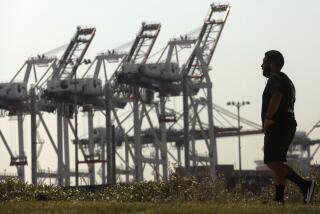Plans for Handling Oil Spills Criticized
Warning of a local disaster equal to the Exxon Valdez spill, environmentalists charged in a report Thursday that oil companies and government agencies along the Los Angeles County coast are ill-equipped to prevent or contain major spills from oil tankers.
“This region faces unnecessary risk because of a lack of clear planning and preparedness for an oil spill,” said Steve Fleischli, executive director of Santa Monica BayKeeper, a nonprofit environmental group. “Such a spill could prove to be an environmental and economic disaster for the region.”
The report concluded that state agencies and cities, particularly those on Santa Monica Bay, do not have adequate resources or contingency plans despite the lessons of the Exxon Valdez debacle in Alaska in 1989 and the American Trader spill off Huntington Beach in 1990.
Just as significantly, researchers charged that oil companies have been drastically cutting their annual funding for oil spill prevention and control since 1994 in a broad attempt to maximize profits.
Government officials and oil industry representatives disputed the report’s conclusions, saying that some are based on dated information. They say they have established adequate safeguards since the Exxon Valdez spilled 11 million gallons of crude oil into Alaska’s Prince William Sound.
Area contingency plans have been developed, they say, as well as agreements between the oil industry and government to dispatch cleanup equipment, vessels and work crews to spill sites. Drills are conducted regularly, they added, and oil tankers are some of the most heavily inspected vessels coming into U.S. waters.
Except for the American Trader accident in Orange County, government officials said, there has not been a major oil spill in Santa Monica Bay or the ports of Los Angeles and Long Beach--the third-largest harbor complex in the world.
The tanker American Trader spilled 400,000 gallons of crude oil off Huntington Beach on Feb. 7, 1990, after the ship bounced on its anchor while tying up to an offshore marine terminal.
“From what I have seen, I don’t feel we are sitting on the brink of an environmental disaster,” said Chief Petty Officer Mark Stephens, a supervisor of the U.S. Coast Guard’s environmental response division in Long Beach. “I feel we are positioned to respond as well as or better than other areas of the country.”
The 60-page report released Thursday was prepared by Environment Now, a foundation started 10 years ago by the family of Frank Wells, a former president of the Walt Disney Co. Santa Monica BayKeeper assisted in the study, which was released at a news conference Thursday.
The study cites a 1992 analysis by the U.S. Minerals Management Service, which said there is a 94% chance that an Exxon Valdez-type spill will occur by 2022 in local waters. The report, however, contains no updated assessment.
“Billions of dollars are at stake in our local economy,” Fleischli said. “We should make more of an effort upfront to make sure a major oil spill doesn’t happen.”
The environmental groups noted that in 1993 and 1994, oil companies provided $450 million to the Marine Spill Response Corp., a nonprofit company that helps clean up oil spills across the country. Since then, the study says, that organization has been downsized and its $95-million annual budget cut to $40 million.
Oil industry officials said that spending on oil spill control has been declining because the large initial investments in equipment, crew training and vessels are no longer needed.
“We probably overspent at the start of the program,” said Doug Henderson, executive director of the Western States Petroleum Assn., which represents 30 major oil companies in six states. “Expenditures are larger at the start of a program than after it gets going. This does not represent any diminishing commitment to the system.”
Among other things, the report stated that tankers coming into the offshore terminal at Chevron’s El Segundo refinery need to have booms placed around them to contain spills if they occur. Henderson said there is no need for the booms because there has never been a major spill. The procedure is already done in the county’s harbors.
Navigation charts need to be updated, the study concluded, and the current tracking by radar of tankers coming into Southern California needs to be expanded north to the Santa Barbara Channel because of the increasing volume of ship traffic.
The report reserved some of its harshest criticism for local cities and two state agencies with oil spill responsibilities--the State Lands Commission and the Office of Oil Spill Prevention and Response in the state’s Department of Fish and Game.
“Currently none of the cities located on the Santa Monica Bay have a clear plan in place to deal with an oil spill catastrophe,” the study concluded. “Although various fire departments have the authority to mobilize forces, there is not a document that outlines a specific plan.”
Researchers said that during the American Trader spill in Huntington Beach, the city did not have an integrated, well-rehearsed response, which resulted in delays in deploying cleanup crews, many of which were untrained.
According to the report, employees of the Office of Oil Spill Prevention and Response are not maritime professionals but “retreaded bureaucrats” trying to keep their jobs. The report states that the State Lands Commission has only seven inspectors for 450 miles of coast from San Diego to Monterey, and cannot adequately monitor the thousands of oil transfers a year from tankers to oil facilities.
Scott Schaefer, acting administrator of the Oil Spill Prevention and Response unit, said the office now has well trained personnel, including Coast Guard veterans.
The office, he said, has taken part in initiatives to prevent oil spills, such as establishing five harbor safety committees, requiring longer tug escorts for tankers, and improving ship tracking systems.
He added that the State Lands Commission, which he used to work for, inspects at least 50% of all oil transfers from tankers at marine terminals.
“Over the last 10 years, I think we have made major improvements in reducing the probability of spills and we have reduced the consequences of the spills that occur,” Schaefer said. “I think some of the criticism is old and no longer valid.”
More to Read
Sign up for Essential California
The most important California stories and recommendations in your inbox every morning.
You may occasionally receive promotional content from the Los Angeles Times.











